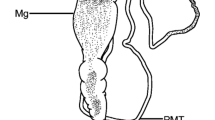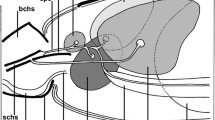Abstract
The larval Malpighian tubules of Sarcophaga ruficornis Fab. consist of two types of cells, namely principal and stellate cells. The principal cells are characterized by a large euchromatic nucleus, well-developed basal plasma membrane infoldings associated with mitochondria and prominent luminal microvilli containing mitochondria with well-developed cristae. The central cytoplasm of the cells contains clear vacuoles, lysosomes, mineral concretions or spherocrystals, lipid droplets and peroxisomes. The stellate cells are thin with extremely short basal plasma membrane infoldings and luminal microvilli devoid of mitochondria. The ultrastructural features of the principal cells show the characteristic of transporting cells engaged in water and ion transport. The cells are separated by septate junctions. The tubules are richly supplied by the tracheae.
Similar content being viewed by others
References
Alberts B., Bray D., Lewis L., Raff M., Roberts K. and Watson J. D. (1994) Molecular Biology of the Cell, 3rd edn. Garland Publishing Inc., New York, NY.
Alkassis W. and Schoeller-Raccaud J. (1984) Ultrastructure of the Malpighian tubules of blow fly larva, Calliphora erythrocephala Meigen (Diptera: Calliphoridae). International Journal of Insect Morphology and Embryology 13, 215–231.
Arab A. and Caetano F. H. (2002) Segmental specializations in the Malpighian tubules of the fire ant Solenopsis saevissima Forel 1904 (Myrmicinae): an electron microscopical study. Arthropod Structure and Development 30, 281–292.
Beard M. E. and Holtzman E. (1987) Peroxisomes in wildtype and rosy mutant Drosophila melanogaster. Proceedings of the National Academy of Sciences of the USA 84, 7433–7437.
Berridge M. J. and Oschman J. L. (1969) A structural basis for fluid secretion by Malpighian tubules. Tissue and Cell 1, 247–272.
Berridge M. J. and Oschman J. L. (1972) Transporting Epithelia. Academic Press, New York, London.
Bradley T. J. (1985) The excretory system: structure and physiology, 421–465 pp. In Comprehensive Insect Physiology, Biochemistry and Pharmacology (edited by G. A. Kerkut and L. I. Gilbert), Vol. 4. Pergamon Press, Oxford.
Bradley T. J., Stuart A. M. and Satir P. (1982) The ultrastructure of the larval Malpighian tubules of a saline-water mosquito. Tissue and Cell 14, 759–773.
Chapman R. F. (2008) The Insects: Structure and Function, 4th edn. Cambridge University Press, New York, Melbourne, Madrid, Cape Town, Singapore, São Paulo. 770 pp.
Dow J. A. T. (2009) Insights into the Malpighian tubule from functional genomics. Journal of Experimental Biology 212, 435–445.
Gaertner L. S. and Morris C. E. (1999) Accumulation of daunomycin and fluorescent dyes by drug transporting Malpighian tubule cells of the tobacco horn worm Manduca sexta. Tissue and Cell 31, 185–194.
Garayoa M., Villaro A. C., Montuenga L. and Sesma P. (1992) Malpighian tubules of Formica polyctena (Hymenoptera): light and electron microscopic study. Journal of Morphology 214, 159–171.
Gillott C. (2005) Entomology, 3rd edn. Springer, The Netherlands. 831 pp.
Green L. F. B. (1979) Regional specialization in the Malpighian tubules of the New Zealand glow-worm Arachnocampa luminosa (Diptera: Mycetophilidae). The structure and function of type I and II cells. Tissue and Cell 11, 673–702.
Hazelton S. R., Townsend V. R., Richter C., Ritter M. E., Felgenhauer B. E. and Spring J. H. (2002) Morphology and ultrastructure of the Malpighian tubules of the Chilean common tarantula (Araneae: Theraphosidae). Journal of Morphology 251, 73–82.
Hruban Z. and Rechcigl M. (1969) Microbodies and related particles: morphology, biochemistry, and physiology. International Review of Cytology 1, 296.
Jarial M. S. (1988) Fine structure of the Malpighian tubules of Chironomus larva in relation to glycogen storage and fate of hemoglobin. Tissue and Cell 20, 355–380.
Kapoor N. N. (1994) A study of the Malpighian tubules of the plecopteran nymph Paragnetina media (Walker) (Plecoptera: Perlidae) by light, scanning electron, and transmission electron microscopy. Canadian Journal of Zoology 72, 1566–1575.
McGettigan J., McLennan R. K., Broderick K. E., Kean L., Allan A. K., Cabrero P., Reguiski M. R., Pollock V. P., Gould G. W. and Davies S. A. (2005) Insect renal tubules constitute a cell-autonomous immune system that protects the organism against bacterial infection. Insect Biochemistry and Molecular Biology 35, 741–754.
Maddrell S. H. P. (1971) The mechanisms of insect excretory systems. Advances in Insect Physiology 8, 199–331.
Maddrell S. H. P. (1977) Insect Malpighian tubules, pp. 541–569. In Transport of Ions and Water in Animals (edited by B. L. Gupta, R. B. Moreton, J. L. Oschman and B. J. Wall). Academic Press, New York, London.
Maddrell S. H. P. (1981) The functional design of the insect excretory system. Journal of Experimental Biology 90, 1–15.
Maddrell S. H. P. and Gardiner B. O. C. (1974) The passive permeability of insect Malpighian tubules to organic solutes. Journal of Experimental Biology 60, 641–652.
Nicolson S. W. (1993) The ionic basis of fluid secretion in insect Malpighian tubules: advances in the last ten years. Journal of Insect Physiology 39, 451–458.
Noirot-Timothée C. and Noirot C. (1980) Septate and scalariform junctions in arthropods. International Review of Cytology 63, 97–140.
Pannabecker T. L., Aneshansley D. J. and Beyenbach K. W. (1992) Unique electrophysiological effects of dinitrophenol in Malpighian tubules. American Journal of Physiology 263, 609–614.
Pannabecker T. (1995) Physiology of the Malpighian tubule. Annual Review of Entomology 40, 493–510.
Skaer H., Le B., Harrison J. B. and Maddrell S. H. P. (1990) Physiological and structural maturation of a polarised epithelium: the Malpighian tubules of a blood-sucking insect, Rhodnius prolixus. Journal of Cell Science 96, 537–547.
Sohal R. S. (1974) Fine structure of the Malpighian tubules in the housefly, Musca domestica. Tissue and Cell 6, 719–728.
Sohal R. S. and Lamb R. E. (1979) Storage-excretion of metallic cations in the adult housefly, Musca domestica. Journal of Insect Physiology 25, 119–124.
Sohal R. S., Peters P. D. and Hall T. A. (1976) Fine structure and X-ray microanalysis of mineralized concretions in the Malpighian tubules of the housefly Musca domestica. Tissue and Cell 8, 447–458.
Sohal R. S., Peters P. D. and Hall T. A. (1977) Origin, structure, composition and age-dependence of mineralized dense bodies (concretions) in the midgut epithelium of the adult housefly, Musca domestica. Tissue and Cell 9, 87–102.
Wall B. J., Oschman J. L. and Schmidt B. A. (1975) Morphology and function of Malpighian tubules and associated structures in the cockroach, Periplaneta americana. Journal of Morphology 146, 265–306.
Wessing A. and Eichelberg D. (1975) Morphology of the Malpighian tubules of insects. Fortschritte der Zoologie 23, 124–147.
Wessing A. and Zierold K. (1992) Metal-salt feeding causes alterations in concretions in Drosophila larval Malpighian tubules as revealed by X-ray microanalysis. Journal of Insect Physiology 38, 623–632.
Wessing A., Zierold K. and Polenz A. (1999) Stellate cells in the Malpighian tubules of Drosophila hydei and D. melanogaster larvae (Insecta, Diptera). Zoomorphology 119, 63–71.
Author information
Authors and Affiliations
Corresponding author
Rights and permissions
About this article
Cite this article
Pal, R., Kumar, K. Ultrastructural features of the larval Malpighian tubules of the flesh fly Sarcophaga ruficornis (Diptera: Sarcophagidae). Int J Trop Insect Sci 32, 166–172 (2012). https://doi.org/10.1017/S1742758412000252
Accepted:
Published:
Issue Date:
DOI: https://doi.org/10.1017/S1742758412000252




